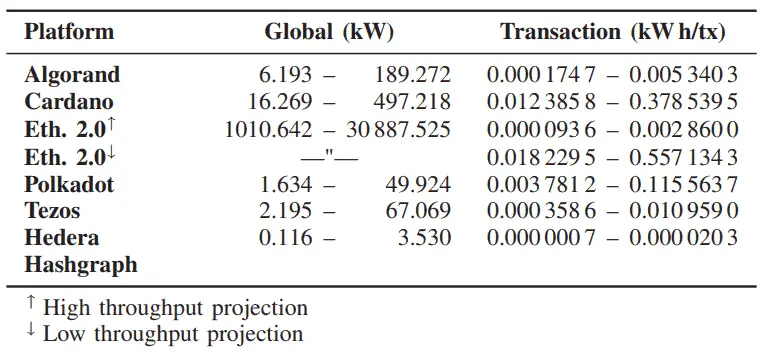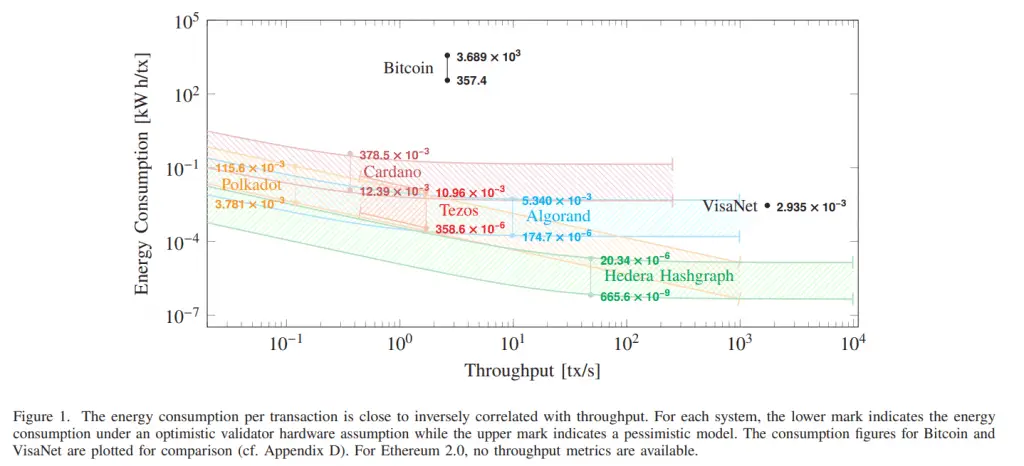
NFTs or non-fungible tokens are a topic that have been under the spotlight for negative reasons; these reasons include projects providing little utility (or value), being a straight up rugpull (or scam), and for the environmental impact they have.
While it’s true that some people create NFTs with malicious intentions – as with any gold rush or fast opportunities to make money – how much of the ‘NFTs are bad for the environment’ argument is actually true?
As a general statement it is impossible to say the environmental impact NFTs are having as this depends on the underlying blockchain technology on which the NFT project is built on. Some blockchains are energy intensive while others are carbon neutral.
How can this be possible?
We will explain this reasoning from a conceptual standpoint as well as by taking a look at actual data pertaining to energy use.
NFTs are built atop the blockchain; depending on the blockchain, but more specifically by examining the mining consensus algorithm of that specific blockchain, we are able to assess the environmental impact of these digital assets.
When a NFT is minted or essentially uploaded to the blockchain, the energy it consumes depends on the algorithm of the blockchain the NFT is minted on. Most NFTs are built atop green blockchains and consume little energy.
Again, we will cover the quantitative amount in the next section of our article so stick around; but first, we need to understand the different consensus algorithms as they vastly differ in energy consumption.
Blockchain consensus algorithms are most commonly built atop either the Proof of Work (PoW) or the Proof of Stake (PoS) algorithm.
The PoW is more energy intensive as miners compete amongst one another to verify transactions, with only the fastest miner contributing to the success or validation of a transaction.
All miners are competing amongst one another to verify the transaction in a PoW model; this becomes energy intensive yet results in only one miner receiving the reward with the others simply consuming energy without providing any discernible utility.
The PoW model is why a powerful GPU is needed in order to effectively mine cryptocurrencies.
On a separate yet related note, if you are interested in mining cryptocurrencies on the typical Apple or Windows laptop and would like to evaluate the profitability, click here.
Now, let’s dive into the other most commonly used blockchain consensus algorithm known as proof of stake (PoS).
The PoS is the less energy intensive algorithm of the two as only one validator is selected to authenticate a transaction. Those who stake more of the blockchain’s governing token are more likely to be selected to verify a transaction and therefore receive a reward.
Since only one person or computer is selected in the PoS algorithm, little energy is consumed.
When comparing the two, the main difference is that more energy is used in the PoW model because of the amount of computers running the algorithm (and competing to be the first one to verify a transaction).
Recently, we have seen a trend of consumers and creators being more energy aware. Ethereum – the cryptocurrency with the second largest market cap – and likely the blockchain that sees the most transactions, switched from the energy intensive PoW algorithm to the relatively green PoS algorithm.
So how different are the two consensus blockchain in energy consumption?
According to ethereum.org, which is an reputable site, Ethereum in the PoS model consumes approximately 0.0026 TWh/yr while Ethereum in the PoW model consumes 78 TWh/yr. To put this into perspective, YouTube consumes an astounding 244 TWh/yr.
Find attached a visual representation, our team has screenshotted from ethereum.org.

Now that we have covered the difference in energy consumption between the two most popular blockchain algorithms, and we have an understanding of energy consumption relative to other companies, let’s take a look at the amount of energy an NFT transaction consumes.
How Much Energy Does An NFT Transaction Consume?
Again, the amount of energy an NFT consumes really depends on the consensus mechanism that blockchain uses. The PoW algorithm is far more energy intensive than PoS.
As a general statement, Ethereum with the proof of stake consensus model consumes approximately 0.0000936 – 0.0028600 kWh per transaction (using a high throughput estimation); examples of transactions would include the minting of an NFT or the exchange of cryptocurrencies between wallets.
It is important to note that our team found this information from a research paper conducted by University College London (UCL). A more in-depth look into these numbers will be provided below.
Attached is a more in-depth look at energy transactions from other blockchains.

To make this data more understandable, our team will mention that a 100-watt light bulb would have to run for 10 straight hours before consuming 1kWh of energy. With the mean per transaction consumption of Ethereum (for high throughput projections) on the PoS model consuming approximately 0.0014768 kWh per transaction, there would have to be roughly 678 transactions to reach 1 kWh of energy.
On a more general level, this means that the PoS energy transaction consumption is comparable to that of the traditional, centralized payment system VisaNet.
Attached is a graph taken from UCL’s research paper:

This data is based on TPS (transactions per second) which measures transaction throughput.
Hardware utilization, based on what a typical workload would be for a transaction to be validated, is used.
For those two reasons, a more optimistic and pessimistic estimate is given with many of the transactions likely falling somewhere in the middle of this range.
From this data, it is clear that a PoS consensus model is much more energy effective relative to the PoW alternative; logically, this makes sense as there are fewer computers competing to be the first to verify transactions.
Some argue that this does come with potential downsides with regards to decentralization; in an extreme example, if there is only one validator, the system is essentially centralized.
One validator is an extreme example and often not the case; with Tron – the blockchain created by Justin Sun – there are 27 validators at a given time (and these are known as super representatives). To become a super representative, you must be elected and pay which deters bad actors.
Another important finding from this study is that not all PoS consensus models consume the same amount of energy. Validator nodes that store more information consume more energy so depending on the storage mechanics a PoS blockchain uses, more or less energy will be consumed.
Additionally, our team wants you to keep in mind that this metric is challenging to measure for a number of different reasons; factors like the type of hardware that blockchain validators are using and where the energy source is coming from are two key metrics that greatly impact the energy consumption for a transaction (and again are difficult to measure).
Measuring the per-transaction consumed for NFT and crypto transactions is difficult because factors like layer two energy consumption is often not taken into account.
Layer one is the underlying foundation or the building blocks of a given blockchain. Layer two is typically more advanced and is primarily responsible for communicating with layer one – in order to handle scaling. The two often work together and the layer two energy consumption is often not taken into account.
Without taking all of these factors into account, finding the exact energy consumption per transaction is difficult and without defining exactly what is entailed in the terms ‘per-transaction’, this number can be highly variable.
Anecdotal studies from miners and reports have also come out stating that customizing validator hardware can greatly affect energy consumption.
If you would like to further examine this study conducted by UCL, we will link that here.
This brings us to the next section of our article, which is a question our team has commonly been asked.
Is Tezos The Most Environmentally Friendly NFT?
The most environmentally friendly NFTs will be those that are built atop a blockchain that is using a proof of stake model.
Transactions among different proof of stake (PoS) blockchains differ by approximately 1 × 103 (when comparing the highest to the lowest energy consumption). This difference in PoS energy consumption is negligible when compared to blockchains that use the proof of work algorithm.
While a difference of 1 x 103 for proof of stake algorithms is actually quite large when comparing within the realm of proof of stake – this difference is negligible in comparing the overall energy consumption between the two models.
This difference was illustrated in the UCL research paper our team previously cited.
To illustrate this point, our team will look at Ethereum energy consumption when using the proof of work algorithm and Ethereum once it has switched to a proof of stake algorithm.
The difference is approximately a 30,000% increase in energy savings – for the same blockchain – when using the proof of stake algorithm instead of the proof of work algorithm.
In the grand scope of things and relative to the energy consumed by other industries, NFTs on the proof of stake blockchain algorithm are quite environmentally friendly.
Now that our team has cleared up some of the common misconceptions regarding the FUD (fear, uncertainty, and doubt) that people have about NFTs energy usage, let’s examine the impact NFTs actually have.
Are NFTs Helping Or Hurting The Environment?
There are instances where NFTs, or the underlying infrastructure behind this technology, have provided a beneficial way to track carbon emissions – and therefore help the environment. IBM has partnered with Energy Blockchain Labs to create a platform for companies to monitor their carbon emissions.
Using IBM’s blockchain technology, Energy Blockchain Labs has created a permissionless platform that promotes low emissions.
This platform allows companies – especially those that emit a large amount of carbon dioxide – to track their emissions and meet their government-mandated reduction quotas.
One way this is done is by allowing high emission companies to purchase carbon credits from low emitters. Carbon credits are essentially a ticket that allows you to emit a certain amount of greenhouse gasses.
This ensures that all companies – within a specified country or state – don’t emit a total and quantifiable amount of greenhouse gasses; this total amount is often set by the government and is based on established and publicly known emission targets.
Essentially, this platform allows companies to track and trade carbon credits in a trustless and permissionless way. With all transactions being immutable, all data is traceable and therefore the entire process is streamlined while promoting/rewarding green technology.
The process is automated by smart contracts – which are an integral aspect of NFTs that make the technology possible – and in this case work by calculating quotas for enterprises that need to reduce emissions.
This level of transparency that comes with the blockchain but more specifically distributed ledgers helps regulators track and better predict emissions in a way that was previously not possible.
Now that we know that the underlying technology behind NFTs can have a positive impact on the environment, let’s examine this more closely.
Are NFTs Really “Green”?
NFTs are becoming increasingly green as buyers look to purchase NFTs on low emission blockchains like those that use the proof of stake model. While some NFTs are more energy intensive because they are on the proof of work model, others are built for the sole purpose of protecting the environment.
Some NFT projects like Angry Teenagers have undoubtedly had a net positive effect on the environment.
Each NFT from this project results in 46 trees being planted on degraded land in Ghana; this helps the environment but also the community and has resulted in schools being built.
Additionally, every ton of carbon that is captured from the previously degraded land that now has 46 trees helps the project earn even more money because companies pay for carbon credits.
The entire process results in more trees being built and the development of communities in Ghana. More on this unique project can be found here.
This brings us to the next section of our article.
Are NFTs Taking Up Too Much Energy?
NFTs are one aspect of blockchain technology and knowing if they take up too much energy is quite subjective. Ethereum – the blockchain that is second largest in market cap and one that is widely used – consumed 93,846 times less energy than YouTube (on an annual basis).
This information is from publicly available resources and was taken from a graph found on ethereum.org’s website which we will link here.
If you found our content helpful please consider following our team on Instagram, Twitter & TikTok! As well as subscribe to our YouTube! Additionally, please consider supporting our team’s content creation through doing business with our partners: Trade stocks & crypto on Webull – get 2 free stocks. Buy a Ledger hardware wallet. U.S. users can get a crypto trading discount on Binance!
